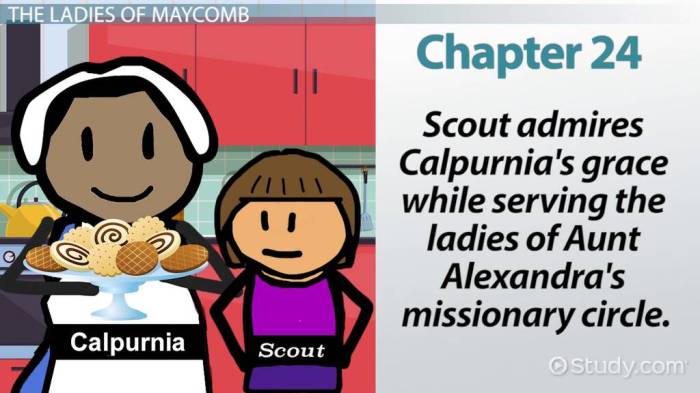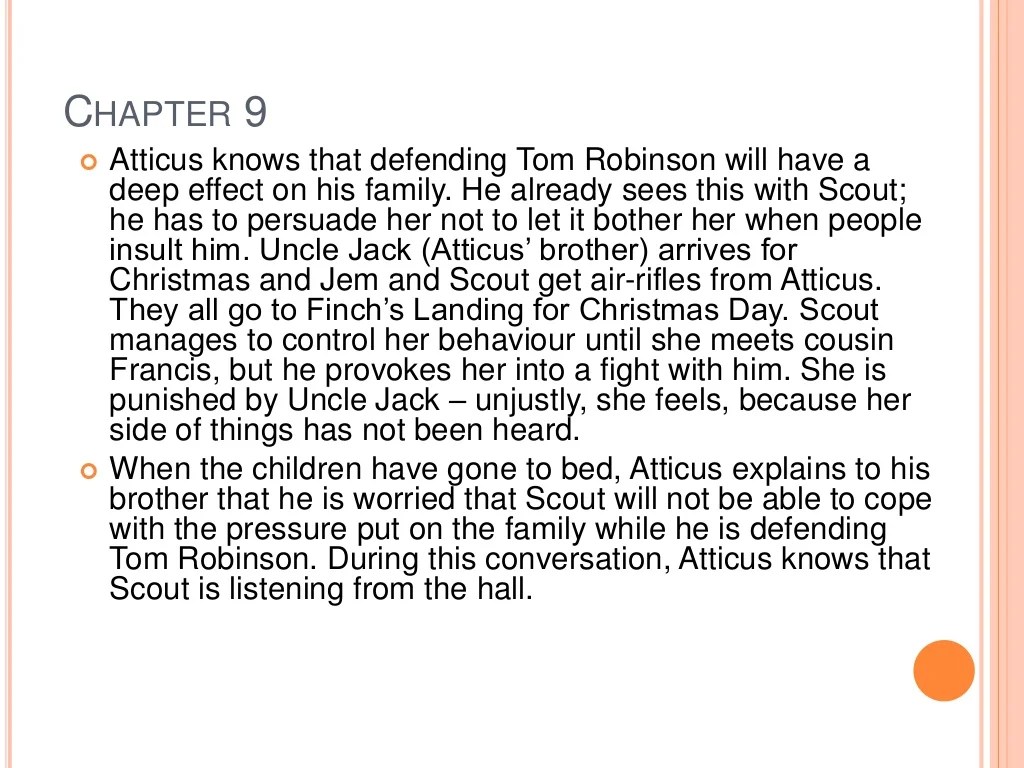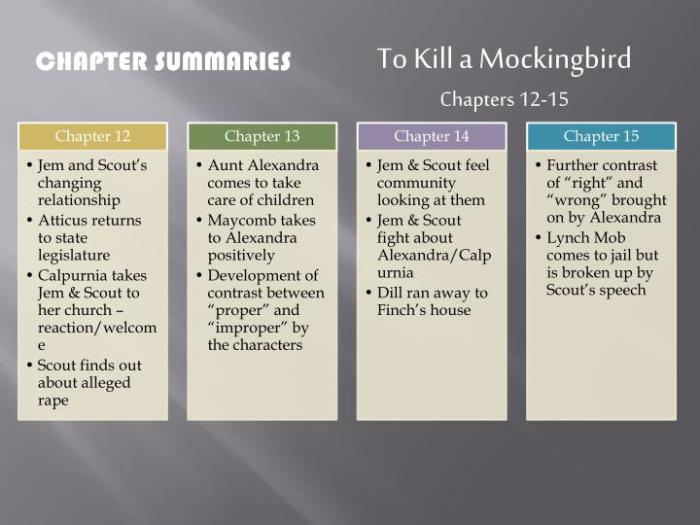Chapter 20 to kill a mockingbird summary – Chapter 20 of Harper Lee’s To Kill a Mockingbird unfolds a pivotal narrative that delves into the moral complexities and social injustices of the American South. This chapter summary delves into the key events, themes, and character developments that shape this compelling chapter, providing a comprehensive analysis for literary enthusiasts and scholars alike.
Chapter Summary

Chapter 20 of To Kill a Mockingbird recounts the trial of Tom Robinson, an African American man accused of raping Mayella Ewell, a white woman. The trial takes place in the courthouse of Maycomb, Alabama, and is presided over by Judge Taylor.
Atticus Finch, a respected lawyer, defends Tom Robinson while Horace Gilmer, the county prosecutor, represents the state. The chapter depicts the tense and emotionally charged atmosphere of the trial, highlighting the racial prejudice and social injustice prevalent in the community.
Key characters in the chapter include Atticus Finch, Tom Robinson, Mayella Ewell, Horace Gilmer, and Judge Taylor. Atticus presents a compelling defense for Tom, arguing that he is innocent and that Mayella’s accusations are false. However, Gilmer’s prosecution relies heavily on racial stereotypes and prejudice, appealing to the jury’s biases and emotions.
The setting of the chapter is the courthouse in Maycomb, a small town in the American South during the 1930s. The atmosphere is tense and oppressive, reflecting the racial tensions and prejudices that permeate the community. The trial becomes a battleground for both justice and injustice, as the jury grapples with the weight of the evidence and the societal pressures surrounding them.
Key Themes
Chapter 20 of To Kill a Mockingbird explores several central themes, including:
- Racial Prejudice:The trial of Tom Robinson highlights the deep-seated racial prejudice and discrimination prevalent in the American South during the 1930s. Gilmer’s prosecution relies heavily on racial stereotypes and appeals to the jury’s biases, demonstrating the extent to which racism shapes the legal system and society.
- Social Injustice:The outcome of the trial exposes the systemic injustice faced by African Americans in the American South. Despite Atticus’s compelling defense, the jury convicts Tom Robinson, demonstrating the failure of the justice system to protect the rights of minorities.
- The Power of Morality:Atticus Finch’s defense of Tom Robinson exemplifies the power of morality and conscience in the face of adversity. Despite knowing that he is unlikely to win the case, Atticus remains steadfast in his belief in Tom’s innocence and fights for justice.
Character Development: Chapter 20 To Kill A Mockingbird Summary

Chapter 20 of To Kill a Mockingbird showcases significant character development for Atticus Finch:
- Moral Compass:Atticus’s unwavering commitment to defending Tom Robinson, despite the overwhelming odds, demonstrates his strong moral compass and principles. He believes in the inherent equality of all people and is willing to fight for justice, even when it is unpopular.
- Courage and Integrity:Atticus’s courage and integrity are evident throughout the trial. He faces the hostile courtroom and the town’s prejudice head-on, refusing to compromise his beliefs or resort to unethical tactics.
- Empathy and Understanding:Atticus’s defense of Tom Robinson is marked by his empathy and understanding of the human condition. He recognizes the suffering and injustice faced by African Americans in the American South and uses his voice to advocate for their rights.
Other characters who undergo significant development in this chapter include:
- Tom Robinson:Tom’s dignity and resilience in the face of false accusations and prejudice highlight his strength and courage.
- Mayella Ewell:Mayella’s complex and tragic character is revealed through her testimony, shedding light on the social and economic factors that contribute to her situation.
Symbolism and Foreshadowing

Chapter 20 of To Kill a Mockingbird employs several instances of symbolism and foreshadowing:
- The Mockingbird:The mockingbird, a symbol of innocence and harmlessness, is mentioned throughout the novel. Tom Robinson’s conviction foreshadows the tragic consequences of harming an innocent person.
- The Courthouse:The courthouse represents the legal system and the pursuit of justice. The trial’s outcome foreshadows the systemic injustice faced by African Americans in the American South.
- The Weather:The stormy weather during the trial symbolizes the emotional turmoil and tension surrounding the case. The rain and thunder can be seen as a metaphor for the social unrest and racial tensions that permeate the community.
Social Commentary

Chapter 20 of To Kill a Mockingbird offers a powerful social commentary on the racial tensions and prejudices of the American South during the 1930s:
- Racial Inequality:The trial of Tom Robinson exposes the deep-seated racial inequality and discrimination prevalent in the community. The jury’s decision to convict Tom despite the lack of evidence demonstrates the extent to which racism shapes the justice system and society.
- The Role of Prejudice:The chapter highlights the destructive power of prejudice and stereotypes. Gilmer’s prosecution relies heavily on racial stereotypes, appealing to the jury’s biases and emotions. This demonstrates how prejudice can cloud judgment and lead to injustice.
- The Importance of Empathy:Atticus’s defense of Tom Robinson emphasizes the importance of empathy and understanding in combating racial prejudice. He urges the jury to look beyond stereotypes and see Tom as a human being deserving of justice.
Query Resolution
What is the central conflict in Chapter 20 of To Kill a Mockingbird?
Chapter 20 revolves around the trial of Tom Robinson, an African American man falsely accused of raping a white woman. The trial exposes the deep-seated racial prejudices and moral dilemmas that divide the community.
How does Atticus Finch’s character develop in Chapter 20?
Atticus’s unwavering commitment to justice and his defense of Tom Robinson demonstrate his moral compass and unwavering principles. Despite facing opposition and threats, he remains steadfast in his belief in equality and the rule of law.
What is the significance of the mockingbird symbolism in Chapter 20?
The mockingbird represents innocence, vulnerability, and the destructive nature of prejudice. The killing of the mockingbird foreshadows the tragic events that will befall Tom Robinson and highlights the consequences of racial hatred.